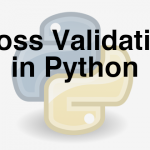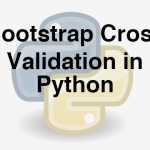
Link to the previous post : https://statinfer.com/204-4-10-cross-validation/
Ten-fold Cross – Validation
- Divide the data into 10 parts(randomly)
- Use 9 parts as training data(90%) and the tenth part as holdout data(10%)
- We can repeat this process 10 times
- Build 10 models, find average error on 10 holdout samples. This gives us an idea on testing error.
K-fold Cross Validation
- A generalization of cross validation.
- Divide the whole dataset into k equal parts
- Use kth part of the data as the holdout sample, use remaining k-1 parts of the data as training data.
- Repeat this K times, build K models. The average error on holdout sample gives us an idea on the testing error.
- Which model to choose?
- Choose the model with least error and least complexity.
- Or the model with less than average error and simple (less parameters).
- Finally use complete data and build a model with the chosen number of parameters.
- Note: Its better to choose K between 5 to 10. Which gives 80% to 90% training data and rest 20% to 10% is holdout data.
Practice : K-fold Cross Validation
- Build a tree model on the fiber bits data.
- Try to build the best model by making all the possible adjustments to the parameters.
- What is the accuracy of the above model?
- Perform 10 -fold cross validation. What is the final accuracy?
- Perform 20 -fold cross validation. What is the final accuracy?
- What can be the expected accuracy on the unknown dataset?
Solution
In [34]:
##Defining the model parameters
tree_KF = tree.DecisionTreeClassifier(criterion='gini',
splitter='best',
max_depth=30,
min_samples_split=30,
min_samples_leaf=30,
max_leaf_nodes=60)
In [35]:
#Importing kfold from cross_validation
from sklearn.cross_validation import KFold
In [36]:
#Simple K-Fold cross validation. 10 folds.
kfold = KFold(len(Fiber_df), n_folds=10)
In [37]:
## Checking the accuracy of model on 10-folds
from sklearn import cross_validation
score10 = cross_validation.cross_val_score(tree_KF,X, y,cv=kfold)
score10
Out[37]:
In [38]:
#Mean accuracy of 10-fold
score10.mean()
Out[38]:
In [39]:
#Simple K-Fold cross validation. 20 folds.
kfold = KFold(len(Fiber_df), n_folds=20)
In [40]:
#Accuracy score of 20-fold model
score20 = cross_validation.cross_val_score(tree_KF,X, y,cv=kfold)
score20
Out[40]:
In [41]:
#Mean accuracy of 20-fold
score20.mean()
Out[41]:
With 10-fold kross validation we can expect Accuracy : 76.29%.
With 20-fold kross validation we can expect Accuracy : 77.98%.
The next post is about bootstrap cross validation.
Link to the next post : https://statinfer.com/204-4-12-bootstrap-cross-validation/




